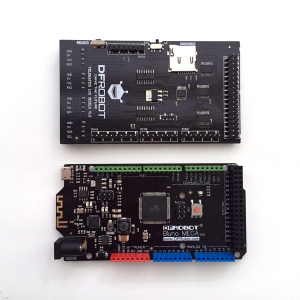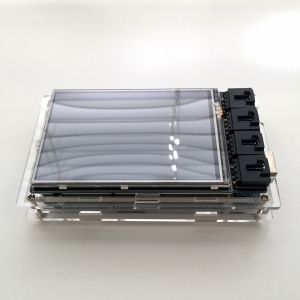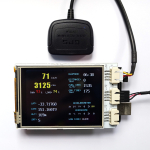Arduino Builder was recently updated. In this release, AVR GCC has been upgraded to version 4.9.1. Arduino core and libraries files have been synchronised with Arduino IDE 1.7.10. Some minor UI issues were solved. If you don’t know about the software, head for its home page.
Author Archives: Stanley
Simple test sketch for UTouch library
Here is a simplest touch screen test sketch (display X,Y on serial) using UTouch library for common Arduino LCD shield.
#include <UTouch.h>
UTouch myTouch( 6, 5, 4, 3, 2);
void setup()
{
myTouch.InitTouch();
myTouch.setPrecision(PREC_MEDIUM);
Serial.begin(115200);
}
void loop()
{
while (myTouch.dataAvailable())
{
myTouch.read();
long x = myTouch.getX();
long y = myTouch.getY();
if (x != -1 && y!=-1 && x != 319)
{
Serial.print("X=");
Serial.print(x);
Serial.print(" Y=");
Serial.println(y);
}
}
delay(20);
}
Tested with


Newly released Telematics Shield with 3.5″ LCD (R61581 controller)
Arduino Builder 0.9.1 Released
The new version has added an option of “Optimize for Speed” which Arduino IDE does not provide. This will make your sketch compiled into faster code but larger in size. Download the latest release from here.
Arduino library for SIM800 for GPRS/HTTP communication
Recently I obtained a cheap (under $8) teeny-tiny SIM800 breakout board. The serial UART interfaced SIM800 makes it very easy for any embedded system to add cellular network access and connect to the cloud. The breakout board has a Mirco SIM seat the the back of the PCB.
After some efforts, I managed to make it work with an Arduino Leonardo. Basically 5 wires are needed to connect the module to Arduino and they connect pins of VCC/GND/Rx/Tx/Reset. This is quite straight-forward. The module’s VCC can’t directly connected to that of Arduino as SIM800 requires a working voltage of 3.7V-4.2V. So a dixode is needed to step down the voltage a bit. The basic programming to make the module work was soon done by referring to the SIM800 AT command-set manual.
Arduino Builder updated and synced with Arduino IDE 1.6.4
Arduino Builder was just updated. The new release contains header and library files from Arduino IDE 1.6.4. AVR toolchain and AVRDUDE are also updated to latest version.
Download the latest release from here.
2.2″ TFT LCD shield for Arduino with microSD and I/O sockets
Here comes a brand new TFT LCD shield for Arduino. It features:
- 2.2″ TFT LCD screen of 320×240@16bpp
- ILI9341 controller (SPI)
- I2C socket (SDA, SCL, VCC, GND)
- UART socket (Rx, Tx, VCC, GND)
- Analog socket (A2, A3, VCC, GND)
- MicroSD socket (supporting up to 32GB SDHC)
- Push button (D8)
- Reset button
- Compatible with Arduino UNO R3 and Bluno
The screen is driven by SPI with fast rendering speed. It is supported by MultiLCD library which provides easy API for displaying characters/digits of various size and drawing bitmaps. It can also be used with UTFT library.
This product can be order from Freematics Hardware Store.
Switching among Arduino LCD shields or modules with ease
 Recently I developed a library for ease the job of displaying texts and numbers on different LCD/OLED modules. This is mainly for my OBD-II data logger project which can be made up of different sets of Arduino hardware. I named the library as Arduino Text Display Library for Multiple LCD, or short as MultiLCD.
Recently I developed a library for ease the job of displaying texts and numbers on different LCD/OLED modules. This is mainly for my OBD-II data logger project which can be made up of different sets of Arduino hardware. I named the library as Arduino Text Display Library for Multiple LCD, or short as MultiLCD.
The library encapsulates several libraries for various Arduino LCD/LED display shields or modules into a set of unified APIs.
Currently it supports these hardware:
- DFRobot LCD4884 shield
- Nokia 3310/5100 LCD module
- LCD1602 shield
- SSD1306 OLED module
- ZT I2C OLED module
Cheers on the all new Arduino Yún!
Finally Arduino combies with Linux. The name is also brilliant! Yún(云) means cloud in Chinese language and that indiciates this Arduino goes up to the cloud, with either WIFI or RJ45. There is USB host and MicroSD socket onboard too.
 Continue reading
Continue reading
Arduino SD card picture viewer with TFT LCD shield
I just started to play with TFT LCD screen with Arduino. I used Itead 2.8″ TFT shield which is said to work great with UTFT library. Taking into account that Arduino has too limited Flash to hold a full frame of picture, and that the shield has a SD card socket on the back, I decided to make a SD card picture viewer as my first approach.
The 8-bit AVR-based Arduino has not only limited storage but also limited computation power. It is impossible to decode JPEG or PNG on-the-fly with Arduino, nor is it possible to load a whole bitmap from SD card into SRAM. The image files have to be stored in raw data format and loaded and rendered portion by portion. The native data format of the TFT control chip is RGB565 (2 bytes for a pixel, 5 bits for red, 6 bits for green, 5 bis for blue). So I used MediaCoder, which is a universal media transcoder I developed, to generate the raw image data of RGB565. It can also convert video files to a sequence of image files.
OBD-II + GPS + G-force data logger based on Arduino MEGA2560
This will be the most comprehensive OBD-II data logger kit and also the biggest in size as it is based on Arduino MEGA2560. Te kit consists of:
- Arduino MEGA2560
- Arduino MEGA I/O extension shield
- Arduino OBD-II Adapter Model B
- 2.8″ TFT LCD shield for Arduino (with SD socket)
- UART GPS Receiver (5Hz or 10Hz)














